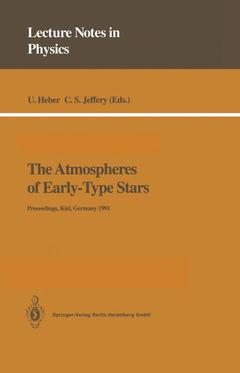Description
The Atmospheres of Early-Type Stars, Softcover reprint of the original 1st ed. 1992
Proceedings of a Workshop Organized Jointly by the UK SERC’s Collaborative Computational Project No. 7 and the Institut für Theoretische Physik und Sternwarte, University of Kiel Held at the University of Kiel, Germany, 18–20 September 1991
Lecture Notes in Physics Series, Vol. 401
Coordinators: Heber Ulrich, Jeffery C. Simon
Language: English
Subject for The Atmospheres of Early-Type Stars:
Keywords
Accretion; LOPES; Variation; development; galaxy; gravity; magnetic field; photometry; planet; spectroscopy; star; stars; stellar evolution; telescope; white dwarf
Publication date: 08-2014
452 p. · 17x24.4 cm · Paperback
452 p. · 17x24.4 cm · Paperback
Description
/li>Contents
/li>
These workshop proceedings aim to provide a broad overview of recent developments in the study of hot stars, both from the observational and the theoretical point of view. Included are first results from the Hubble Space Telescope and ROSAT, the effects of non-radial pulsations, mass loss, magnetic fields, and diffusion, as well as modern theoretical methods to treat radiative transfer and compute model atmospheres. Many new results are described, including the discovery of a B star in the halo of M31. Together the reviews provide a general overview of hot-star spectroscopy suitable for preparing advanced lecture courses and as an introductory text for graduate students.
Galactic B-type Stars.- Non-LTE analyses of B stars.- Galactic B-type supergiants.- On the determination of effective temperature and surface gravity using Strömgren uvbyß photometry.- The mass and helium discrepancy in massive young stars.- A comparison between the orbital masses of early type binary components and masses predicted by stellar evolution.- B-type stars in young clusters.- Chemical abundances in early B-type stars.- The determination of accurate cosmic abundances from B-type stellar spectra.- The origin of distant B-type stars in the galactic halo.- Galactic abundance gradients from ob-type stars in young clusters and associations.- Ionizing radiation from early-type stars.- Abundance patterns in a stars: Carbon and silicon.- Quantitative analysis of A-type supergiants.- Abundances in rapidly rotating a stars.- Statistical equilibrium of Al I/II in a stars and the abundance of aluminium in Vega.- Analyses of B-type stars in the Magellanic Clouds.- The chemical composition of main sequence stars in the Magellanic Clouds.- GHRS observations of O Stars in other galaxies.- The winds of hot stars in M31 and M33.- Wolf-Rayet stars.- Spectrophotometry of Wolf-Rayet stars.- Near-Infrared Spectroscopy of Galactic Wolf-Rayet Stars.- Luminous Blue Variables.- Observed evolutionary changes in the visual magnitude of the luminous blue variable P Cygni.- Forbidden lines of [Fe II] and [N II] in P Cygni's envelope.- Spectroscopic observational data on P Cygni and comparison with the model of the bistable wind.- The spectroscopy of unusual high luminosity stars: HD 168607 and 6 Cas.- Discrete absorption components in O-type stars.- Analysis of circumstellar spectra of s dor.- Comoving frame calculations for ?-cephei.- Nonradial pulsations of O- and B-stars.- Analysisof line profile variations in pulsating B stars.- Mode identification of pulsating stars from line profile variations with the moment method.- Mode identification in beta Cephei stars from UV observations.- Magnetic fields in hot stars.- The structure of Ap star magnetic fields.- Diffusion, mass loss and accretion in stars.- Photospheric abundances in late-A and Am-Fm stars.- Effective temperature and models for early a stars: Application to 78Vir (A2P).- Silicon abundances in normal and mercury-manganese type late-B stars.- Radiative accelerations on Ga and Al ions in stable atmospheres of CP stars.- Si II autoionization lines in stratified atmosphere of Bp star.- He - variables.- Variable H? emission in the helium-strong star ? orionis C.- Lambda Bootis stars.- A spectroscopic abundance analysis of Lambda Bootis stars first results in LTE.- Hot subluminous stars.- The spectra of blue horizontal branch stars.- Weight watching in M 15.- Looking for gaps.- More on the progenitors of white dwarfs.- Non-LTE analysis of the Palomar Green subdwarf O stars.- A statistical complete sample of hot subdwarfs.- NLTE analysis of a SDO binary: HD128220.- NLTE analysis of helium rich subdwarf O stars.- Analysis of PG 1159 stars.- NLTE analysis of the hydrogen-deficient central star of the planetary nebula Abell 78.- Optical observations of the ultrahigh-excitation pre-white dwarf KPD 0005+5106.- The atmospheres of extreme helium stars.- Mass loss from ? Sgr and other helium stars.- Blue post-asymptotic giant branch stars at high galactic latitude.- Old planetary nuclei and their evolutionary connections.- Analysis of central stars of old planetary nebulae: Problems with the Balmer lines.- Hot white dwarfs.- ROSAT observations of white dwarfs.- Carbon enrichment in the outerlayers of hot helium-rich high gravity stars.- Prospective EUVE observations of hot white dwarfs.- Spectra of interacting binary white dwarf stars.- The opacity project — A review.- The Lyman ? line wing and application for synthetic spectra of DA white dwarfs.- Ion-atom complexes and the absorption of radiation in stellar plasma.- Ion-atom complexes and the recombination in stellar plasma.- Stark broadening parameters for spectral lines of multicharged ions in stellar atmospheres: C IV, N V, O VI lines and regularities within an isoelectronic sequence.- On Stark line shifts in spectra of very hot stars.- Accelerated Lambda Iteration.- Instabilities in hot-star winds: Basic physics and recent developments.- Radiation-driven wind theory: Not (yet?) working.- Radiation-driven wind theory: The influence of turbulence.- Application of the etla approach in the comoving frame to the study of winds in hot stars.- Interactive LTE spectrum synthesis.- Calculations of line positions in the presence of magnetic and electric fields in white dwarf spectra.- Treatment Of strong magnetic fields in very hot stellar atmospheres.- Blends, frequency grids and the Scharmer scheme.- Multilevel non-LTE radiative transfer using exact complete and diagonal operators.- Iron line blanketing in NLTE model atmospheres for O stars: First results.- Calculations of non-LTE radiative transfer in extended outflowing atmospheres using the Sobolev approximation for line transfer.- 3d radiative line-transfer for disk-shaped be star envelopes.
© 2024 LAVOISIER S.A.S.
These books may interest you

White Dwarfs 52.74 €



